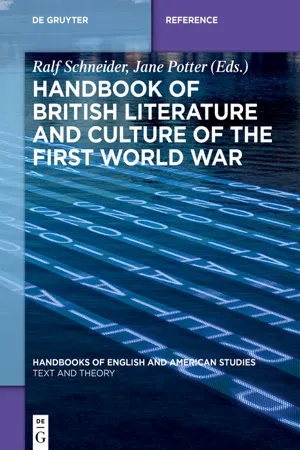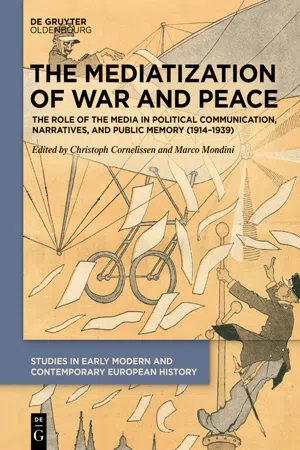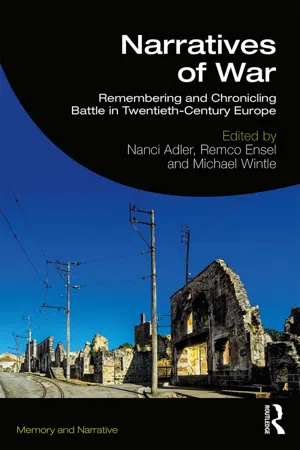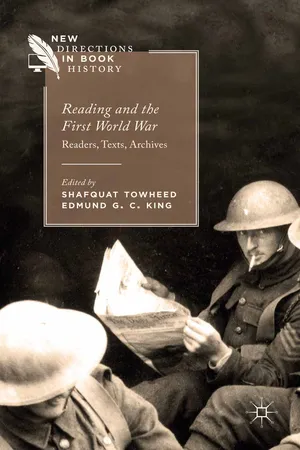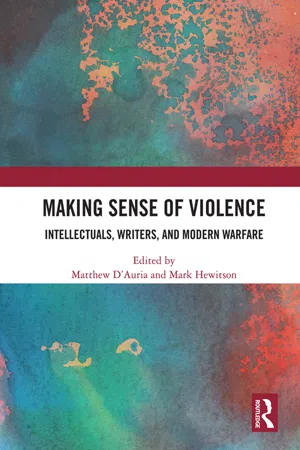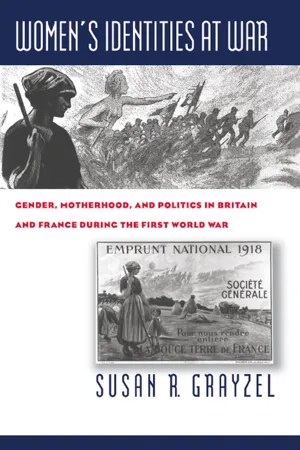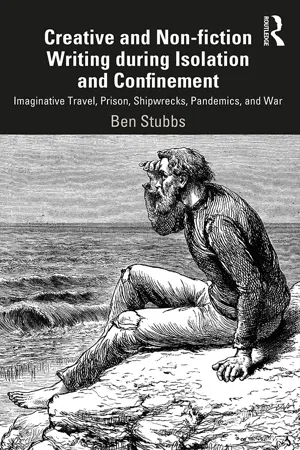Literature
First World War Fiction
First World War fiction refers to literary works, including novels and short stories, that are set during or inspired by the events of World War I. These works often explore the impact of the war on individuals and society, depicting the harsh realities of combat, the psychological effects on soldiers, and the broader social and political changes brought about by the war.
Written by Perlego with AI-assistance
Related key terms
Related key terms
1 of 4
Related key terms
1 of 3
11 Key excerpts on "First World War Fiction"
- Ralf Schneider, Jane Potter(Authors)
- 2021(Publication Date)
- De Gruyter(Publisher)
The Oxford History of the Novel in English. Part IV: The Novel 1914–1940. Eds. Patrick Parrinder and Andrzej Gasiorek. Oxford et al.: Oxford University Press, 2010. 401–416.4 The Short Story of the First World War
Ann-Marie EinhausAbstract
This chapter outlines the contribution made by short fiction to the representation and memory of the First World War. Drawing on short stories published between 1914 and the war’s centenary years, this chapter argues that short fiction can reveal as much about the multifaceted global experience of war as about the war’s shifting place in contemporary cultural memory. The short story of and about the First World War is explored both as an archive of experience and a mediator of memory.Key Terms: Memory, short fiction, publishing, global war, anthologies,1 Introduction: Functions and Definitions
Wartime and inter-war short stories about the First World War were written and published as part of a wider boom in short fiction, facilitated by the success of periodicals in Britain and elsewhere in the early twentieth century, which continued into the 1940s. As far as public attention and critical scrutiny go, the British short story about the First World War has been the poor cousin of writing about the war in other genres. Yet next to the war’s poetry it was in fact one of the most prolific genres in which the experience of war found expression. Like the treatment of the First World War in the British novel, its representation in short fiction did not stop with the end of the war, and this chapter discusses examples of First World War short fiction ranging from the war years to the centenary period. The First World War short stories discussed here were chosen to illustrate two things in particular: the relation of the short story to the war’s global nature, and to its evolving cultural memory. Just as the war’s memory originates in countless individual experiences and memories, short stories at the time offered a vast patchwork of views, aspects and nuances of the conflict. Over time, both the war’s collective memory and its literary canon became subject to rather similar processes of selective remembering and forgetting, and so we find ourselves confronted today with not only a limited cultural memory of the war that invited so many challenges and additions in the run-up to the centenary, but also a limited literary understanding of the First World War. Like buried but still accessible memories, short stories have the capacity to be rediscovered, to nuance and diversify our understanding of the war’s literary experience.- eBook - ePub
The Mediatization of War and Peace
The Role of the Media in Political Communication, Narratives, and Public Memory (1914-1939)
- Christoph Cornelissen, Marco Mondini(Authors)
- 2021(Publication Date)
- De Gruyter Oldenbourg(Publisher)
4 .The British experience was not unique, and even though to date there is no global (or European) census of World War I literature, individual national case studies can help establish the extent of a writing (and publishing) bulimia that was not limited to the more literate nations5 . According to the most recent surveys, and even considering only published items (ego-documents, memoirs, diaries, fiction, or poems) circulating in the editorial market after 1914 and written by veterans and/or dedicated to the war experience, the numbers are remarkable even if approximate. In the 1920s, in his seminal work on war writers as witnesses, Jean Norton Cru proposed a corpus of 246 authors for an overall total of 300 prose works. Cru applied a very restrictive definition to decide who could be considered both an écrivain combatant (soldier writer) and a témoin (witness). He excluded all forms of fiction and those reporting only personal experience, as well as all poetic production (known to be massive already during wartime)6 . This methodological choice was later widely criticized. In July 1919, the Association des Ecrivains Combattants (AEC) was founded by 80 veterans who claimed to act on behalf of more than 500 writers killed “on the field of honor”, whose works were collected and published by the AEC between 1924 and 1926 in a five-volume anthology. In his more analytical comparative studies of French and German war literature, Nicolas Beaupré recorded 239 French speaking war authors who published their memoirs before 1920, and while the data remain uncertain, there is no doubt about the orages de papier that overwhelmed the French literary sphere7 . The German language world was similarly characterized by what was baptized as “die Textmasse”. Not surprisingly, as one of the states with the most advanced media and entertainment industries (as well as one of the most comprehensive scholastic systems), the German case is a good demonstration of the compulsive boom in writing (and publishing) starting immediately after the declaration of war. According to Julius Bab, who compiled a critical anthology of German poetry during early postwar period, the wave of enthusiast patriotic poems in the first months of the conflict could be estimated in the millions8 . A bibliography compiled by a group of scholars in 2008 recorded 7,973 titles classed as war literature published in Germany and German speaking Austria between 1914 and 19399 . Even in Italy, a semi-literate nation where more or less half the population could not read or write in 1914, the Great War likewise triggered a bulimic season of writing. A recent survey of books dealing with World War I lists more than 1500 items for the two decades between 1919 and 1940. This corpus could be summed with the mass of memorial brochures celebrating the fallen, a popular literary genre in Italy after 1915, of which about 2300 have been catalogued. However, it would be misleading to confuse these materials with the corpus of eyewitness literary accounts and narrations of the conflict in circulation. These remained the hegemonic genre of the Italian publishing market at least until the 1960s with a canon of no more than 300 titles10 - eBook - ePub
Narratives of War
Remembering and Chronicling Battle in Twentieth-Century Europe
- Nanci Adler, Remco Ensel, Michael Wintle(Authors)
- 2019(Publication Date)
- Routledge(Publisher)
Part IIIThe Development and Deployment of War Narratives
Passage contains an image
First World War Novels and Veteran Memory Dunja Dušanić7 The War Books Controversy Revisited
The sudden eruption of war books that swept through Europe at the end of 1920s and the beginning of the 1930s was one of the most widely discussed aspects of the ‘boom’ of cultural production prompted by the tenth anniversary of the 1918 Armistice. In those years, the literary market was overwhelmed to the point that Louis Aragon, complaining in 1930 of an offensive comeback of war literature, diagnosed that war was again à la mode. 1 Although almost every piece of writing published on the subject of the Great War seemed to get an unprecedented amount of attention from the readers and the press, in the copious and varied production of war books, novels tended to elicit the strongest emotional response and incite the loudest polemics.The debates on war novels, also known in Britain as the ‘War Books Controversy’, seemed to be centred on the representation of the First World War in recent fiction, particularly on its ‘truthfulness’. This highly elusive notion was used to refer to everything from the novels’ factual accuracy to their ideological content, but most often served as a pretext for moving the discussion away from the actual texts and onto a different, extra-literary terrain. At first glance, then, both the focus and the vigour of the controversy appear more as symptoms of a serious crisis of memory than as a reaction to any particular feature of the actual novels. And yet, while one might be inclined to agree that they were indeed signs of ‘a perplexed international self-commiseration’2 and ‘a deep anxiety about the future of the political, moral, and cultural order’,3 they were not generated by the political climate of the interwar years alone. The War Books Controversy was, as Samuel Hynes observed, ‘a quarrel over history; but it was also a literary dispute’.4 - Jennifer Haytock(Author)
- 2018(Publication Date)
- Routledge(Publisher)
Literature and the Great War, in which he explores “how influentially the Great War dealt with text – with language and its representation of the world – and with what effects for literary form and imagination at the time and later” (xii). While Fussell, Stevenson, and others look to literature produced in the 1920s for evidence of disillusionment with language and meaning, Hutchison, by looking at the works of writers-observers of the war, shows how language seemed to crumble as the war actually occurred.Literary critics have tended to study American World War I literature jointly with British writing, in part because the British output was so much greater. Some of these studies offer useful comparative insights into the body of World War I literature in English. Yet because the British and American experiences of the war differed so greatly, it’s useful to examine American war literature separately. While the British were involved in the war right from its beginning, the United States joined much later; the nation was at war for about eighteen months rather than four years. Since that time period included mobilization and transportation to Europe, many American soldiers engaged in combat for only a few months, if at all. Unlike the British, they did not spend years rotating into trenches and enduring daily shellings, although those experiences did make an impression. There were differences on the home front too: wounded British soldiers could be shipped back to England for treatment and recuperation, but Americans generally did not see the wounded bodies until after hostilities were over. For American civilians, the war and its consequences occurred largely out of sight.Unlike the Revolutionary War and the Civil War, which had causes that were publicly debated over time, the Great War inspired little pre-war writing. Most Americans were unaware of rising tensions in Europe, were caught off guard when hostilities broke out, and were not interested in getting involved. During the war, however, as Mark W. Van Wienen and Hutchison have shown, many American writers played out responses to the war in public writings, including poems, stories, and songs. In Britain, censorship practices were put in place immediately, but Americans had time to circulate ideas, questions, and arguments about the meaning of the war and the U.S.’s place in it. Gradually, with the spread of Allied propaganda, the rise of submarine warfare and its interference with American civilians and trade, and concern about foreign spies, the idea of “preparedness” began to take hold in the cultural imagination. Temple Bailey’s Tin Soldiers (1918) establishes an ideology of partnership between a courting couple in which the man eventually assumes his responsibilities as a soldier and the woman accepts her role as the domestic partner, both making material and emotional sacrifices to support the war effort. In this novel, female characters who refuse to acknowledge the United States’ moral responsibility to Europe or to practice “wheatless” and “meatless” days are shown to be lacking in “real” womanhood. Ellen Glasgow, in The Builders (1919), proposes a new role for women forged by the war: rather than remaining in the domestic sphere, the nurse Caroline Meade uses her skills on behalf of the war effort. She and her male counterpart also develop a shared ideology of a new world rising from the conflagration in Europe, one in which the integrity of the nation grows immediately from the contributions of each citizen. Mary Roberts Rinehart’s Dangerous Days- eBook - ePub
- Ashley Chantler, Rob Hawkes(Authors)
- 2016(Publication Date)
- Routledge(Publisher)
9 Ford and the First World War Andrew Frayn DOI: 10.4324/9781315566856-10Ford Madox Ford occupied a distinctive and often ambivalent national, literary and intellectual position in response to the First World War. His version of the war was consequently out of step with many of his contemporaries, of which he was conscious: ‘the only work that one does that is any good is always the work one does against the grain’.1 Ford was a British subject with German ancestry, still known during the war as Ford Madox Hueffer, which made him a target for heightened scrutiny; he was also a committed Francophile.2 For many early twentieth-century authors the war was their first major subject, and for some their only subject. By contrast, Ford had already published prodigiously for over twenty years in a variety of forms and genres. The war became an epoch-defining event for Ford not least because, as Trudi Tate bluntly puts it, ‘being a soldier was Ford’s first real job’.3 However, it did not give Ford the taste for physical labour. Many poets of the war also later wrote memoirs or barely fictionalised novels about it, but Ford wrote about it in almost every conceivable form_ propaganda, poems, short stories, novels, a novel sequence, and autobiographical works. This chapter surveys these writings, and illustrates Ford’s unique position.1 Ford to Stella Bowen (early Sept. 1918), The Correspondence of Ford Madox Ford and Stella Bowen, ed. Sondra J. Stang and Karen Cochran (Bloomington: Indiana University Press, 1993), p. 11.2 Ford’s ambivalent national identity is discussed by Christine Berberich in Chapter 13 of this volume. He satirises the heightened fear of the Germanic and its consequences in the short story ‘The Scaremonger’, which is reproduced in War Prose, ed. Max Saunders (Manchester: Carcanet Press, 1999), pp. 142–8.3 Trudi Tate, Modernism, History and the First World War - eBook - ePub
Reading and the First World War
Readers, Texts, Archives
- Shafquat Towheed, Edmund King(Authors)
- 2015(Publication Date)
- Palgrave Macmillan(Publisher)
Part IReading and the Formation of the Literary CanonPassage contains an image 1 ‘Khaki and Kisses’: Reading the Romance Novel in the Great War
Jane Potter‘What is wanted […] is the friendly companionship of a good and kindly book to take the mind away from the contemplation of the terrible environment.’1 So stated The War Illustrated in December 1915, demonstrating that despite publishers’ initial fears that public interest in and purchasing of books would wane in the harsh conditions of war, print culture remained essential to maintaining and bolstering the mood of both soldiers and civilians between 1914 and 1918. Herbert Jenkins for one averred that,If the war has proved anything it has been the folly of forecast, and in nothing have the prophets been further from the truth than in the anticipation of its effects upon books. People are now reading more than they have read for many years past, and the sale of cheap books has been remarkable.2Perhaps more so than during any conflict before or since, books and periodicals played an essential role in the First World War. The trade in Britain was in its ‘Golden Age’: technical innovations, marketing and advertising strategies, and distribution networks were firmly in place. Literacy levels were higher than they had ever been thanks to the Education Acts that had continually improved school provision since the 1870s. With little competition from other media, reading was an important source of distraction from the hardships of war. Those on active service, whether in the trenches or convalescing in hospital, were a captive audience and ‘the demand for the novelist who could dispel the boredom of war was limitless’.3 Publishers responded enthusiastically to this demand. Jenkins, this time writing in the Daily Mirror of 1915, asserted that novels were invaluable sources of comfort and amusement for ‘the man at the Front, the wounded, the bereaved’, and declared that he had personally ‘received many very touching testimonies of the gratitude of those who want to forget things occasionally for an hour or so’.4 His assertion can be verified to some extent by Signaller John Ivor Hanson, who observed in his wartime journal that, ‘Books of all kinds circularise among the troops … something readable is a boon; it passes an otherwise monotonous hour and helps us forget.’5 The hero of Joseph Hocking’s novel All for a Scrap of Paper - eBook - ePub
Making Sense of Violence
Intellectuals, Writers, and Modern Warfare
- Matthew D'Auria, Mark Hewitson(Authors)
- 2020(Publication Date)
- Routledge(Publisher)
142 This revitalization in turn seemed to offer the possibility of defeating old enemies, pursuing a policy of expansion, and regaining national honour. In a defeated power such as Germany, these radical views became popular during the 1920s and early 1930s. They emerged from a patriotic, even sacred, realm of war literature, in which the horrors of military conflict had been described and justified without inhibition or censorship.Writing about war
A comparison of the content and reception of ‘war literature’ in the United Kingdom and Germany reveals striking similarities in the diction, imagery and form of letters, diaries, memoirs and novels.143 Written accounts of the war drew on existing traditions and vocabularies which allowed authors to describe events and explore feelings during the war as well as after it in ways that were usually forbidden for painters, cinematographers and playwrights.144 For proponents of high culture, such as Thomas Hardy, the shift marked a decline of poetry and ‘the barbarizing of taste in the younger minds by the dark madness of the late war’.145 To D. H. Lawrence, it was symptomatic of the fact that people ‘have felt much more deeply and strongly these last few months’, leading to the discrediting of ‘“serious” works whose feeling is shallower than that of the official army reports’.146 Writers like Lawrence self-consciously called upon private expressions – which were occasionally published – of fear, jubilation, numbness and despair on the part of combatants during the conflict itself.The boundaries between the varying types of war literature were not clear-cut. During the conflict, letters were printed routinely in the press. Newspaper and magazine articles regularly contained the testimony of eye-witnesses, from which they derived much of their veracity and authority.147 In both Britain and Germany, hundreds of memoirs, diaries, collections of letters and other non-fiction ‘war books’ were published in the decades after 1918.148 Many memoirs were written by officers and ordinary soldiers, with some relying heavily on diaries and others on an individual’s power of recollection. ‘Literary’ accounts variously imitated and extended the war memoir as a form of authentic testimony, rendering them ‘generically mixed’.149 Jünger’s In Stahlgewittern (1920) uses the form of a diary. Edmund Blunden’s Undertones of War (1928) is a memoir but it includes the testimony of others in order to describe what war was like elsewhere.150 Ludwig Renn’s Krieg (1928) is presented as an autobiographical memoir, yet its protagonist is an ordinary soldier, whereas Renn himself was an officer. Graves’s memoir Goodbye to All That (1929) frequently shifts to a third-person narrator or relates ‘typical’ anecdotes through an empty first-person narrator (‘I’). The experiencing self, which establishes – or seeks to establish – the authenticity of the account, is deliberately intermixed with the narrating self, which interprets events.151 Sassoon’s Memoirs of an Infantry Officer (1930) created the fictional character of George Sherston in the manner of a novel, before going on to detail the events which had actually befallen the author. At the same time, the novel was a satire, alternating between graphic description and comic exaggeration.152 Many works combined caricatural or grotesque visions with ‘factual’ reportage or historical narrative. Karl Kraus’s sprawling satirical drama Die letzten Tagen der Menschheit, composed and published between 1915 and 1922, had deployed these combinations to devastating effect.153 Both Richard Aldington’s Death of a Hero - eBook - ePub
Women's Identities at War
Gender, Motherhood, and Politics in Britain and France during the First World War
- Susan R. Grayzel(Author)
- 2014(Publication Date)
- The University of North Carolina Press(Publisher)
Literature also proved one of the most important media for transgressing these borders and conveying, despite censorship, a diverse set of responses to the war to a broad audience of men and women. As recent studies by James Smith Allen and Joseph McAleer have shown, the populations of France and Britain during the Great War contained more readers than ever before. Allen finds that literacy was “nearly universal” in France by the end of the nineteenth century, and it had increased dramatically among women. He argues that as French audiences diversified, gradually comprising broader age groups, non-Parisians, and more social classes, “women shared to a greater extent in the world of print.” 2 McAleer’s study of popular reading in twentieth-century Britain draws on evidence from publishing practices to explore the rise of “lower-middle/working-class” culture, particularly its literary forms. According to McAleer, by the war’s end, women “presented a large and captive market ready to be exploited by advertisers and by publishers dispensing romance and adventure.” In particular, the commercialization of fiction made separating popular and mass fiction more difficult; works by romantic novelists, like Ruby M. Ayres, were meant to be both popular and “for mass consumption.” McAleer provides more information about reading habits during the Second World War, yet his study of changes in publishing practices and readers’ reactions to popular and mass literature suggests that British audiences during the First World War saw reading as “a popular leisure activity.” Although wartime fiction generally reflected some prevalent attitudes and concerns—endorsing marriage, motherhood, and a patriotic outlook—it was also subject to the whims of the reading public - eBook - ePub
Creative and Non-fiction Writing during Isolation and Confinement
Imaginative Travel, Prison, Shipwrecks, Pandemics, and War
- Ben Stubbs(Author)
- 2022(Publication Date)
- Routledge(Publisher)
titillating novels of “sheer balderdash”, as Virginia Woolf called them (ibid., p.8), but from ordinary soldiers. They were isolated in the trenches, yet still writing in a manner that allowed for a closeness that had not been seen before. The trench poetry of the war also allowed the adoption of a much wider variety of poets, where previously publishing opportunities had been reserved for those who approached literacy and literature with a capital ‘L’, as writes George Walter in The Penguin Book of First World War Poetry (ibid., p.10), rather than the common soldier. The styles of Imagism—being precise and radical, and Georgian—less formal, more colloquial and realist, were seen as highly influential in the production of war poetry. Ultimately it was deemed “poetry as reportage” (ibid., p.15) which was as concerned with authenticity as it was with the aesthetics of language of these soldier poets that had a lasting impact: We ate our breakfast lying on our backs, Because the shells were screeching overhead. I bet a rasher to a loaf of bread That Hull United would beat Halifax When Jimmy Stainthorpe played full-back instead of Billy Bradford. Ginger raised his head And cursed, and took the bet; and dropt back dead. We ate our breakfast lying on our backs, Because the shells were screeching overhead. (Wilfred Gibson, ‘Breakfast’, in Walter, 2006, p.63) Tens of thousands of poems were written and set back to magazines, journals, and newspapers during the First World War, though not many have lasted and are still reprinted (Walter, 2006), with this largely being due to subject matter, where the legacy is now around perpetuating the horrors of war and sympathising with those who endured it (ibid., p.25). White (1987) has previously written about soldiers’ notion of themselves in the First World War as tourists in foreign lands and how this provided them with “a protected barrier … precious detachment … to distance themselves from the horrors around them” (ibid., p.71) - eBook - ePub
- Charles A. O'Connor(Author)
- 2014(Publication Date)
- New Academia(Publisher)
6
Postwar Western Literature
If people bring so much courage to this world the world has to kill them to break them, so of course it kills them. The world would break everyone and afterward many are strong at the broken places. But those that will not break it kills. It kills the very good and very gentle and very brave impartially. If you are none of these you can be sure it will kill you too but there will be no special hurry.— Ernest Hemingway, A Farewell to Arms (1929)1Here was a new generation, ... grown up to find all Gods dead, all wars fought, all faiths in man shaken.— F. Scott Fitzgerald, This Side of Paradise (1920)2A sense of loss, betrayal, and estrangement reverberates throughout the important literature of all the major combatant nations during and after World War I. In Under Fire (1916) Henri Barbusse’s narrator rails at the “truly unpardonable division” in France between the victimized common soldiers and those back home who caused and profited from the senseless war.3 In Erich Maria Remarque’s All Quiet on the Western Front (1929) Paul Bäumer feels emotionally detached from everyone and everything in Germany during home leave and longs to rejoin his comrades at the Front, who are “weary, broken, burnt out, rootless, and without hope.”4 Robert Graves characterizes his war memoir Good-Bye to All That (1929) as his “bitter leave-taking of England”; it “looked strange to us returned soldiers” and Graves found that “civilians talked a foreign language” and serious conversation even with his parents was “all but impossible.”5 In Ernest Hemingway’s short story “Soldiers Home” (1925), Harold Krebs returns to Oklahoma after serving in all the major American campaigns of World War I to find his family and community acting as if the war had never happened. Krebs becomes disillusioned, withdrawn, and resentful of society’s lack of support, sympathy, and respect for his wartime service.6 - eBook - ePub
- David Ulbrich, Bobby A. Wintermute(Authors)
- 2018(Publication Date)
- De Gruyter Oldenbourg(Publisher)
La Belle Epoque , a time of great optimism and prosperity.All this came crashing down in the warm fall of 1914, as Europeans plunged headlong into most destructive conflict to date in recorded history. Within three years, the United States joined in a conflict so monumental it could only be known for decades to come as “The Great War.” A truly global conflict, with combat theaters spanning three continents and all seven seas, ultimately as many as 38 million men were killed, wounded, and missing in more than four bloody years. This chapter traces the dramatic changes in cultural constructions of masculinity and femininity occurring on battlefields and home fronts during the First World War. This conflict witnessed an existential clash between what social historian Peter Stearns terms as an “inertia of change” resulting from the wartime upheaval, and what literary critic Leo Braudy describes as “centripetal forces” coalescing in the traditionalist resistance to change.181 Seen in this light, the First World War thus can be evaluated as a series of gendered interactions and social engineering experiments, some deliberately calculated, but others occurring quite by accident.Overview
In August 1914, the combination of hyper-nationalism and hyper-masculinity infected many Europeans as millions of men rallied to their flags and fulfilled their gendered responsibilities. Reservists reported to their depots, trading their civilian clothes and tools for uniforms and rifles. Young men, caught up in the moment, queued up at recruiting stations, hoping they would have the opportunity to get their licks in before Christmas, when everyone knew the war would be over. Women too adopted wartime roles, some time-honored, others new. As the mobilizations began, young women and their chaperones prowled the streets, challenging fit-looking men to do their duty. In England, said women were armed with white feathers to press on those resisting, to signify their cowardice. Everywhere women also took up the slack on farms, in offices, and later, in factories, replacing their menfolk who were called off to war. By time of the 1916 bloodbaths on the Eastern and Western fronts, most existing assumptions about the relative spheres occupied by men and women in public life were disrupted, as women took on roles that had hitherto been exclusively male preserves in peacetime.
Index pages curate the most relevant extracts from our library of academic textbooks. They’ve been created using an in-house natural language model (NLM), each adding context and meaning to key research topics.
Explore more topic indexes
Explore more topic indexes
1 of 6
Explore more topic indexes
1 of 4
